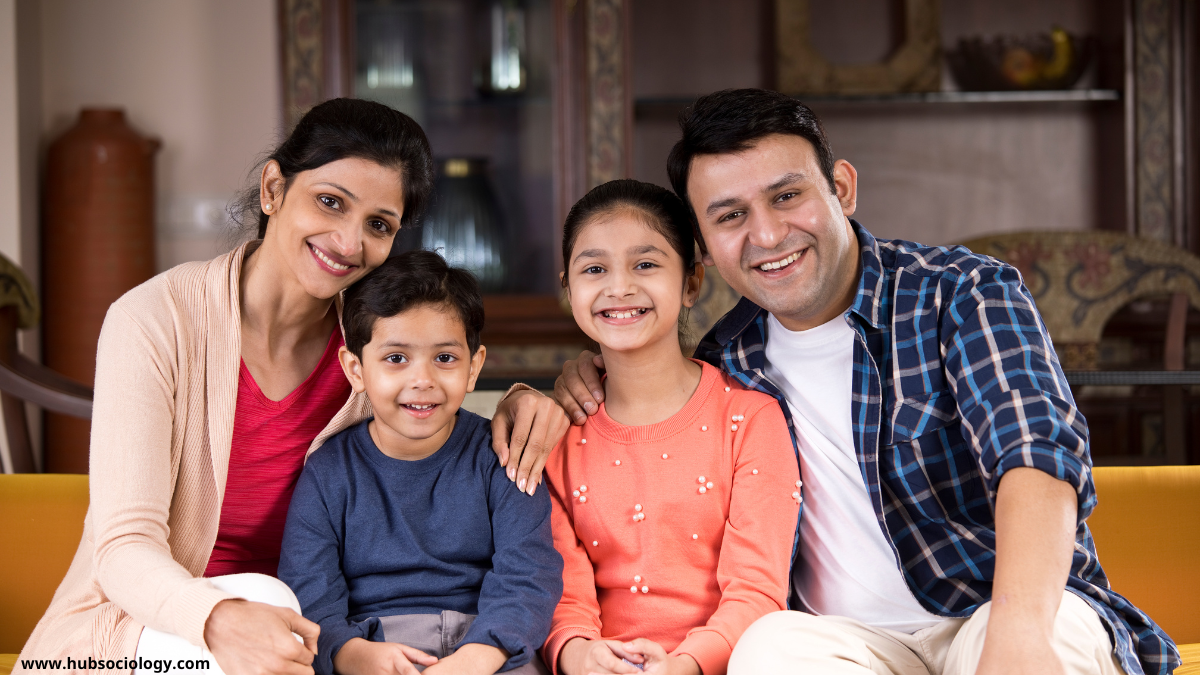Introduction on Family and Household
The family is one of the most fundamental social institutions in India, deeply rooted in cultural, religious, and historical traditions. It serves as the primary unit of socialization, economic support, and emotional bonding. In the Indian context, the family is not just a nuclear entity but often extends into a complex web of kinship ties, forming joint or extended families. The household, on the other hand, refers to the residential and economic unit where family members live together and share resources.
From a sociological perspective, the study of family and household in India involves examining its structure, functions, changing dynamics, and the impact of modernization, urbanization, and globalization. This article explores the traditional and contemporary aspects of family and household in India, focusing on their sociological significance.

Table of Contents
Traditional Family Structure in India
1. The Joint Family System
For ages, Indian society has been characterized by the joint family arrangement. A joint family typically consists of three or more generations living under one roof, sharing common resources, and participating in collective decision-making. This system is prevalent in both rural and urban areas, though its prevalence has declined in recent decades.
Characteristics of Joint Families:
- Collective Living: Multiple generations (grandparents, parents, children, uncles, aunts, and cousins) live together.
- Shared Economy: Income and expenses are pooled, and financial responsibilities are collective.
- Patriarchal Authority: The eldest male member usually holds decision-making power.
- Strong Kinship Bonds: Relationships extend beyond the immediate family, emphasizing loyalty and interdependence.
Functions of Joint Families:
- Economic Security: Members support each other financially, especially in agricultural societies.
- Socialization: Children learn cultural values, traditions, and social norms from elders.
- Care for the Elderly: Older members are looked after by younger generations.
- Division of Labor: Responsibilities are distributed based on age and gender roles.
2. Patriarchal and Patrilineal Structure
Indian families have traditionally been patriarchal, with men holding primary authority. Inheritance and lineage are often traced through the male line (patrilineal), though some communities in South India follow matrilineal systems (e.g., the Nairs of Kerala).
3. Arranged Marriages and Kinship Networks
Marriages in India are often arranged by families, reinforcing kinship ties. Caste, religion, and economic status play crucial roles in marital alliances. The concept of gotra (lineage) and sapinda (close kinship) influences marriage rules, particularly in Hindu families.
Changes in Family and Household Structures

1. Shift from Joint to Nuclear Families
Joint families have gradually given way to nuclear families (parents and their kids) as a result of urbanization, education, and economic opportunity. Factors contributing to this change include:
- Migration: Young professionals move to cities for jobs, leading to smaller household units.
- Economic Independence: Women and younger generations seek financial autonomy, reducing dependence on joint family structures.
- Western Influence: Nuclear family structures are encouraged by exposure to individualistic ideals.
However, many urban families maintain modified extended family ties, where members live separately but stay connected emotionally and financially.
2. Changing Gender Roles
Traditionally, Indian households followed strict gender roles—men as breadwinners and women as homemakers. However, with increasing female education and workforce participation, gender dynamics are evolving. More women are asserting their rights in family decision-making, challenging patriarchal norms.
3. Decline in Fertility Rates
India’s fertility rate has declined due to factors like:
- Family Planning Programs: Government initiatives promoting smaller families.
- Education and Employment: Women delay marriage and childbirth for career pursuits.
- Economic Pressures: Rising costs of child-rearing discourage large families.
4. Rise of Single-Parent and Non-Traditional Households
Divorce, widowhood, and personal choices have led to an increase in single-parent households. Additionally, live-in relationships, same-sex partnerships, and cohabitation—though still stigmatized—are gradually gaining acceptance in urban areas.
Sociological Theories on Family in India
1. Structural-Functional Perspective
According to functionalists like Talcott Parsons, the family serves essential functions for societal stability. In India, the joint family traditionally fulfilled roles such as:
- Socialization: Transmitting cultural values.
- Economic Support: Pooling resources for survival.
- Social Control: Enforcing norms and discipline.
However, modernization has led to functional differentiation, with schools, workplaces, and government taking over some family roles.
2. Conflict Perspective
Marxist and feminist scholars argue that the family perpetuates inequality. In India:
- Caste and Class Hierarchies: Marriages reinforce social stratification.
- Gender Inequality: Patriarchy restricts women’s autonomy.
- Property Rights: Traditional inheritance laws favor male heirs, though legal reforms (e.g., the Hindu Succession Act, 2005) aim for gender equality.
3. Symbolic Interactionism
This viewpoint looks at how family members use their relationships to create meaning. In India:
- Changing Parent-Child Relationships: Increased dialogue between generations compared to earlier authoritarian parenting.
- Negotiation of Roles: In contemporary marriages, couples reinterpret what is expected of them.
Impact of Modernization and Globalization
1. Urbanization and Family Dynamics
Because of space limitations and work commitments, urban living encourages nuclear families. However, emotional ties remain strong, with frequent visits and financial support between relatives.
2. Influence of Media and Technology
- Social Media: Helps maintain long-distance family connections.
- Dating Apps: Challenge traditional arranged marriages by promoting individual choice.
3. Legal Reforms and Women’s Empowerment
Laws such as the Protection of Women from Domestic Violence Act (2005) and rights to ancestral property have empowered women, altering family power structures.
4. Challenges Faced by Modern Indian Families
- Work-Life Balance: Dual-career couples struggle with childcare and elderly care.
- Elderly Isolation: Nuclear families leave aging parents without support.
- Marital Discord: Rising divorce rates indicate changing marital expectations.
Conclusion on Family and Household
The family and household in India are undergoing significant transformations due to socio-economic changes, legal reforms, and globalization. The united family system is dwindling, yet its emotional and cultural importance endures. Modern Indian families balance traditional values with contemporary aspirations, leading to diverse household structures.

From a sociological standpoint, understanding these changes helps in addressing challenges like gender inequality, elderly care, and marital stability. As India progresses, the family will continue to evolve, reflecting both continuity and change in its social fabric.
Topic Related Questions on Family and Household
5-Mark Questions on Family and Household (Short Answer Type)
- Define family and household. How are they different?
- What are the key characteristics of a joint family in India?
- Explain the patriarchal structure of the traditional Indian family.
- How does the patrilineal system influence inheritance in Indian families?
- What are the major functions of the family in Indian society?
- Briefly discuss the impact of urbanization on family structures in India.
- What is the role of arranged marriages in maintaining kinship ties in India?
- How has education influenced changes in the Indian family system?
- What are the reasons behind the decline of joint families in India?
- How does the structural-functional perspective explain the Indian family system?
10-Mark Questions on Family and Household (Descriptive/Analytical Type)
- Discuss the changing trends in family structure in India with reference to the shift from joint to nuclear families.
- Examine the impact of globalization on traditional Indian family values.
- How have gender roles evolved in Indian households in the last few decades?
- Analyze the influence of legal reforms (e.g., Hindu Succession Act) on women’s status in Indian families.
- Compare and contrast the joint family system and the nuclear family system in India.
- Discuss the role of the family in the socialization process in Indian society.
- What are the challenges faced by elderly members in modern Indian families?
- How does the caste system influence marriage and family structures in India?
- Explain the concept of “modified extended family” in the context of urban India.
- Critically evaluate the conflict perspective on the Indian family system.
15-Mark Questions on Family and Household (Long Answer/Essay Type)
- “The Indian family system is undergoing a transition from traditional joint families to nuclear families.” Critically analyze this statement with sociological perspectives.
- Discuss the impact of modernization and urbanization on the structure and functions of the Indian family.
- How do feminist perspectives explain gender inequality within Indian households? Support your answer with examples.
- Examine the role of religion and caste in shaping marriage and family structures in India.
- “The joint family system in India is declining but not disappearing.” Evaluate this statement with suitable arguments.
- How has the rise of individualism affected family relationships in contemporary India?
- Discuss the challenges and opportunities faced by dual-career couples in modern Indian families.
- Analyze the changing dynamics of intergenerational relationships in Indian families.
- “The family in India is both a site of oppression and a source of emotional security.” Discuss with reference to sociological theories.
- What are the future prospects of the Indian family system in the context of globalization and digital transformation?
Additional Higher-Order Thinking Questions on Family and Household (Case Study/Application-Based)
- Case Study: A young working woman in Mumbai prefers to live in a nuclear family, while her parents insist on a joint family setup. Analyze this situation using sociological theories.
- Debate: “The decline of the joint family system is leading to weaker social support systems in India.” Argue for or against this statement.
- Comparative Analysis: Compare the matrilineal family system (e.g., Nairs of Kerala) with the patrilineal system in North India.
- Policy Suggestion: What measures should the government take to support elderly care in nuclear family setups?
